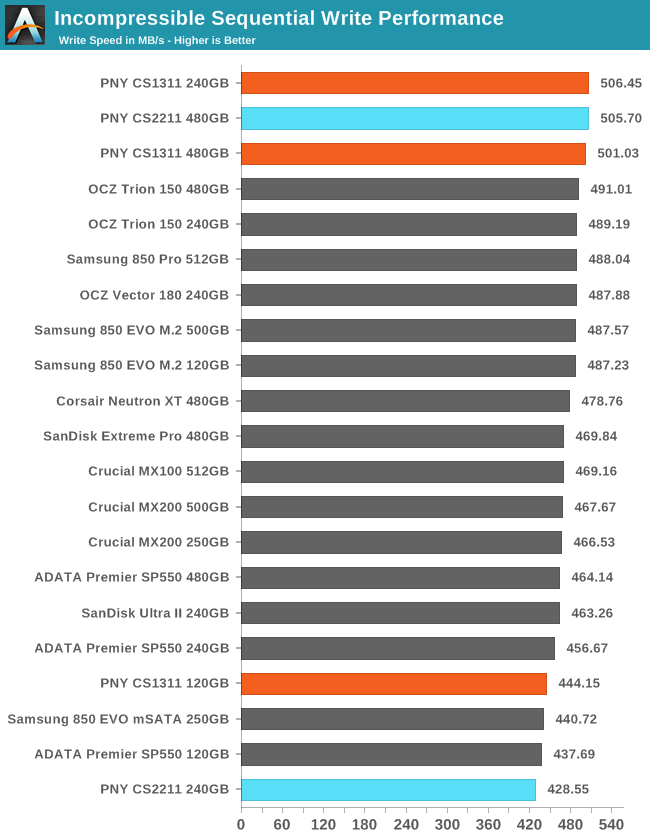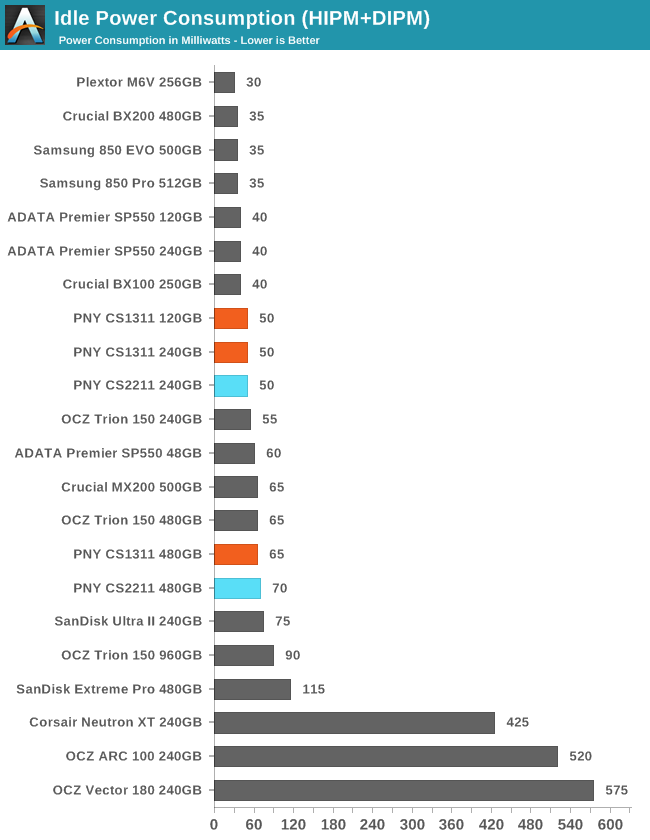The PNY CS1311 and CS2211 SSD Review: MLC vs TLC at 15nm
by Billy Tallis on April 15, 2016 8:00 AM ESTATTO
ATTO's Disk Benchmark is a quick and easy freeware tool to measure drive performance across various transfer sizes.
 |
|||||||||
Aside from the 120GB drive's hobbled write speed, everything looks normal with the ATTO plots. The 120GB drive is just too small to deliver the full performance its controller is capable of, even though it's the smaller variant of the S10.
AS-SSD
AS-SSD is another quick and free benchmark tool. It uses incompressible data for all of its tests, making it an easy way to keep an eye on which drives are relying on transparent data compression. The short duration of the test makes it a decent indicator of peak drive performance.


Peak sequential read speeds of the PNY drives are all top-notch, but the 240GB CS2211 is oddly slow on the write test.
Idle Power Consumption
Since the ATSB tests based on real-world usage cut idle times short to 25ms, their power consumption scores paint an inaccurate picture of the relative suitability of drives for mobile use. During real-world client use, a solid state drive will spend far more time idle than actively processing commands. Our testbed doesn't support the deepest DevSlp power saving mode that SATA drives can implement, but we can measure the power usage in the intermediate slumber state where both the host and device ends of the SATA link enter a low-power state and the drive is free to engage its internal power savings measures.
We also report the drive's idle power consumption while the SATA link is active and not in any power saving state. Drives are required to be able to wake from the slumber state in under 10 milliseconds, but that still leaves plenty of room for them to add latency to a burst of I/O. Because of this, many desktops default to either not using SATA Aggressive Link Power Management (ALPM) at all or to only enable it partially without making use of the device-initiated power management (DIPM) capability. Additionally, SATA Hot-Swap is incompatible with the use of DIPM, so our SSD testbed usually has DIPM turned off during performance testing.


The S10C controller does seem to save a bit of power over the larger S10-X, with and without ALPM. The S10C sets a new record for the best idle power without ALPM.










43 Comments
View All Comments
DanoSpumoni - Saturday, April 16, 2016 - link
When 2TB SSDs drop below $200 then i'll bite... from the current trend it looks like thats only a couple years away maybe lesszodiacfml - Friday, April 15, 2016 - link
It has been like that ever since they unleashed V-NAND drives. Despite being on top, I think they are selling them competitively to remove or not allow smaller players to enter.zepi - Friday, April 15, 2016 - link
At least in Europe Samsung has priced itself out of the game completely. I've yet to see EVO ever even near the top of the GB per euro/£ list when I've been searching for drives. Usually Crucial seems to take to top stop and I've yet to see a reason buy anything else.Like now as I write I see 480GB BX200 being available for 97€ taxes included in amazon.de, cheapest 500GB EVO is 141€, so straight away +45% or something like that. I've yet to see it ever being even remotely competitive with sandisks or corsairs in Europe.
It still seems to sell well though being often in the top lists of many retailers.
DeepLake - Friday, April 15, 2016 - link
Last i checked US prices for Samsung EVO were also very high. I dont know what other commenters are talking about. Are they ignorant or Samsung agents?BrokenCrayons - Friday, April 15, 2016 - link
Thanks for the review. It's good to see SSD prices falling thanks to TLC and a standardized, inexpensive controller. I've been happy with the added capacity at a lower price point thanks to TLC flash. TLC performance behind budget controllers seems good enough now to make MLC SSDs a poor choice in a lot of desktop and laptop usage scenarios.haukionkannel - Friday, April 15, 2016 - link
So true. They Are slover, but the prises are good.hansmuff - Friday, April 15, 2016 - link
They make excellent game drives. With games coming in at 50GB at times, a 480 or 960GB TLC drive with so-so speeds is perfectly acceptable.bug77 - Friday, April 15, 2016 - link
I would love to see the SSD price fall fir any reason but planar TLC :(The performance of planar TLC is not that big of an issue, but the reduced lifetime is.
LostWander - Friday, April 15, 2016 - link
Is the reduced lifetime really that extreme? As far as I've seen it's still far better than anything you would get out of a conventional HDD. Adding in better general performance and it seems like less intensive applications (like a game or media storage drive) would still be perfectly acceptable for TLCbug77 - Friday, April 15, 2016 - link
You get 3 years warranty at most (two years less than MLC/V-NAND TLC) and something like 1000 p/e cycles. Good enough for many things (music, videos), but not if you're writing a lot (e.g. a system drive or a game drive).And while TLC itself is not so bad (it's hardly worth it imho, because it's not much cheaper), if the trend continues we'll have some pretty crappy drives in our hands soon.